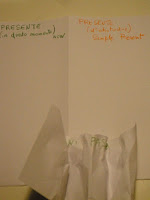What does "flipping the classroom" mean?
Basically it is a teaching method where students have to watch videos for homework while traditional home work is done in class with the teacher supervision.
What I did with my class
I wanted to give it a try. Keeping in mind that the best thing is always to take a "baby step" and start with a small change, this is what I did in a second class of Middle School.
We'd been dealing with present simple tense for some weeks and time had come to move on to the present continuous. The common procedure would have been:
P presentation
P practice
P production
P personalization
But this time we didn't start with the presentation phase.
In class I dictated some sentences in Italian ( their mother tongue ) to the students, who had previously divided a piece of paper into three sections, like this:
They wrote the sentences, in Italian, in the correct section, dividing them into now-actions, habits and past actions.
First thing after doing that, they ripped out the "past actions" part of their paper and they threw it away.

My intention was to make them physically aware of the fact we were dealing with present actions ( yes, maybe it's hard to believe and a bit disappointing, but some of them still had problems in fully grasping the concept of present/past actions ).
Then, as a class activity, we translated the "simple present" sentences into English and that was a revision of our last grammar topic. At this point they were left with some sentences they couldn't translate by applying what they knew. I told them they had to use a new grammar structure but I also declared I wasn't going to tell them anything about it, in other words: I wasn't going to "explain" it to them.
In short, this is what I said:
" Ok, let's see if you can do it by yourself. Go and watch this glogtster. There are some short videos explaining how to use the present continuous. Watch them carefully, as many times as you like, and, when you think you have figured it out, write the "rule" of this new tense on a piece of paper and put it in an envelope. Seal it, write your name on it and hand it in next lesson. I'm going to give you a "plus point" if you do it correctly."
NB
* "plus" and "minus" points are part of our classroom management, a sort of "token economy" approach. Students get plus and/or minus points, which are an integral part of their assessment.
* the envelope had the purpose to charge the activity with a sort of "formality", an official character, to make it appear important to the students' eyes.
I have to say that this task was optional, because not all the students have internet access at home. That's one of the reasons why I called it "the SEMI-flipped" class experiment.
This is the present continuous glogster I had previously done and published online.
The following lesson, 12 students out of 21 had done what I had asked them to do.
Nearly all of them had been able to understand how to form a sentence using the present continuous, as you can see from the pictures.
| Slideshow design made with Smilebox |
First reflections
I was obviously happy about the result especially because the 12 students were not just the best ones.
First thought was: " You see?! They don't even need a teacher..at least, not a teacher in the traditional way..."
and my second reflection was on how to "exploit" those savvy students for the whole class benefit.
So I gave my usual presentation on the topic to the class ( using IWB and Power Point and more ) and in the practice phase we worked in groups. In each group there was at least one present continuous-self-trained student. I got the impression that in the group work there was more energy and enthusiasm than there had been in other occasions.
A lot of practice lessons structured in this way gave them the opportunity to learn and consolidate the grammar point according to their learning styles. One of their final outcomes was the creation of a mindmap, where the main focus was on the two visual reminders ( the bee and the boeing ).
Click here to see another example of mindmap.
Results
Of course, at this point, I'm not able to draw conclusions on the students' ability to retain the information in the long-term memory, neither can I say this was the best way to introduce the topic, but I can share the results of the class test. Far from being the most effective way to assess students' learning, grammar tests are nevertheless quite clear indicators of the students' progression in the initial stages of Bloom taxonomy, that is they show how well a rule, a structure has been remembered and understood.
And the test results were amazing!
The class average test score was 8,4 out of ten, which is definitely high if we consider that middle school classes in Italy are strongly mixed-ability.
Conclusions
I called this experiment "the semi-flipped" classroom for two main reasons:
1) not the whole class watched the videos at home
2) the "explanation" phase was double and not only confined to something to be done at home, but it was used as a sort of reinforcement for some students and as check/verification for others.
It was certainly rewarding and I'd like to consider it a small step on a long path worth walking on.
This is a great infographic to visualize the concept of "flipped classroom"
Created by Knewton and Column Five Media



1 comment:
I know the PPP method is what I taught, but it looks like it's going out the window. Flipping it around seems to work well though.
Post a Comment